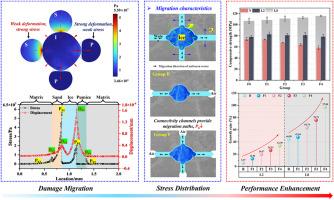超低水胶比胶凝材料(ULWC)低温性能的多尺度孔隙优化:孔隙网络的缓冲机制
IF 10.8
1区 工程技术
Q1 CONSTRUCTION & BUILDING TECHNOLOGY
引用次数: 0
摘要
尽管孔隙网络对混凝土稳定的低温性能至关重要,但对多尺度孔隙结构与低温性能的联系机制的研究仍然有限。本研究采用浮石对超低水胶比胶凝材料(ULWC)的孔隙网络进行调控。利用LT-DSC、1H NMR和CT从微观、中观和宏观角度研究了孔隙特征(包括孔径、均匀性、分形维数和孔隙形状)与低温性能之间的关系。此外,利用纳米压痕和有限元模拟揭示了孔隙网络对ULWC低温性能的控制机制。结果表明:在-80℃时,浮石的加入使其抗压强度增长率由44.38%提高到97.05%;孔隙结构分析表明,浮石促进了凝胶孔隙分形空间的聚集,诱导基质形成更长的球状孔隙。其中,分形维数和孔隙度与低温抗压强度有较强的相关性,基于这两个因素建立的低温强度预测模型的预测精度为0.95。此外,微观结构分析和模拟结果表明,长形球形孔隙的应力耗散特性与低温预应力共同增强了ULWC的低温性能。浮石的低模量及其对微孔网络均匀性的改善可使UHD C-S-H模量的低温损伤率从22.62%降低到0.82%。这些发现为今后有针对性地优化混凝土低温性能提供了理论指导。本文章由计算机程序翻译,如有差异,请以英文原文为准。


Multi-scale pore optimization of ultra-low water binder ratio cementitious materials (ULWC) for low-temperature performance improvement: Buffering mechanism of pore networks
Although the pore network is critical for the stable low-temperature performance of concrete, research on the mechanisms linking multi-scale pore structures to low-temperature performance remains limited. This study employed pumice to modulate the pore network of ultra-low water binder ratio cementitious materials (ULWC). LT-DSC, 1H NMR, and CT were used to investigated the relationships between pore characteristics (including pore size, uniformity, fractal dimension, and pore shape) and low-temperature performance from micro-, meso-, and macroscopic perspectives. Additionally, nanoindentation and finite element simulations were employed to reveal the control mechanisms of the pore network on the low-temperature performance of ULWC. The result showed that the addition of pumice increased the compressive strength growth rate at −80 °C from 44.38 % to 97.05 %. Pore structure analysis indicated that pumice promoted the aggregation of the fractal space of the gel pores and induced the matrix to form more prolate spheroid-shaped pores. Among them, the fractal dimension and porosity were strongly correlated with low-temperature compressive strength, and the low-temperature strength prediction model based on these factors achieved an accuracy of 0.95. Furthermore, microstructural analysis and simulation results suggested that the stress dissipation characteristics of prolate spheroid-shaped pores, in conjunction with low-temperature pre-stress, collaboratively enhanced the low-temperature performance of ULWC. And the low modulus of pumice and its improvement of micropore network uniformity can reduce the low temperatures damage rate of the UHD C-S-H modulus from 22.62 % to 0.82 %. These findings provide theoretical guidance for the targeted optimization of low-temperature performance of concrete in the future.
求助全文
通过发布文献求助,成功后即可免费获取论文全文。
去求助
来源期刊

Cement & concrete composites
工程技术-材料科学:复合
CiteScore
18.70
自引率
11.40%
发文量
459
审稿时长
65 days
期刊介绍:
Cement & concrete composites focuses on advancements in cement-concrete composite technology and the production, use, and performance of cement-based construction materials. It covers a wide range of materials, including fiber-reinforced composites, polymer composites, ferrocement, and those incorporating special aggregates or waste materials. Major themes include microstructure, material properties, testing, durability, mechanics, modeling, design, fabrication, and practical applications. The journal welcomes papers on structural behavior, field studies, repair and maintenance, serviceability, and sustainability. It aims to enhance understanding, provide a platform for unconventional materials, promote low-cost energy-saving materials, and bridge the gap between materials science, engineering, and construction. Special issues on emerging topics are also published to encourage collaboration between materials scientists, engineers, designers, and fabricators.
 求助内容:
求助内容: 应助结果提醒方式:
应助结果提醒方式:


